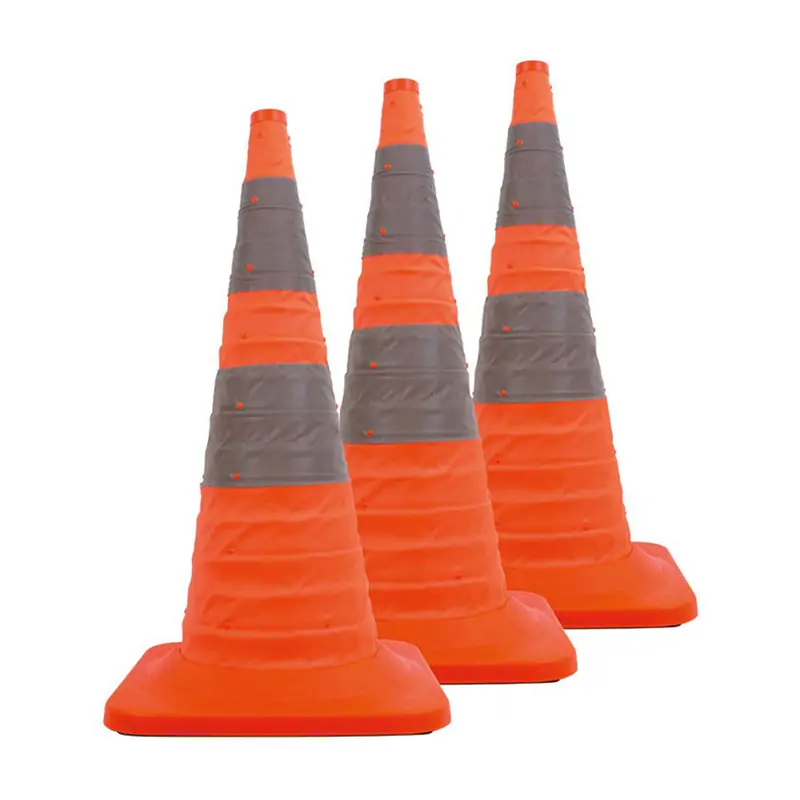Folding traffic cones play a significant role in guiding traffic flow by providing visible and portable markers that can be easily deployed and positioned as needed.
Here’s how they contribute to guiding traffic flow:
- Temporary Lane Marking: Folding traffic cones are often used to mark temporary lanes or designate specific traffic patterns during roadwork, construction, or events. They can be placed along the edges of lanes or in the center of the road to delineate traffic flow and guide drivers safely through the designated route.
- Lane Closure and Diversion: When lanes need to be closed temporarily due to maintenance, accidents, or special events, folding traffic cones are deployed to alert drivers and redirect traffic accordingly. They help create a clear and visible barrier between open and closed lanes, guiding drivers to alternate routes or detours with minimal disruption.
- Pedestrian Safety: Folding traffic cones can also be used to create temporary pedestrian crossings or walkways in areas where sidewalks are unavailable or under construction. By positioning cones along the edges of pedestrian paths, they help delineate safe walking routes and ensure the safety of pedestrians navigating through traffic.
- Parking Management: In parking lots or temporary parking areas, folding traffic cones can assist in organizing parking spaces and guiding vehicles to designated parking areas. They can be placed strategically to indicate parking restrictions, reserved spaces, or temporary parking zones, helping to optimize parking efficiency and minimize congestion.
- Event Management: During special events, parades, or outdoor gatherings, folding traffic cones play a crucial role in managing traffic flow and ensuring the safety of participants and spectators. They can be used to create temporary road closures, establish event boundaries, and direct vehicles to designated parking areas or drop-off points.
- Emergency Response: Folding traffic cones are valuable tools for emergency responders, enabling them to quickly establish traffic control measures at accident scenes, road closures, or other emergency situations. They help create a safe working environment for emergency personnel and guide traffic away from hazardous areas, minimizing the risk of secondary accidents or injuries.
- Visibility Enhancement: Folding traffic cones are typically equipped with reflective bands or strips that enhance their visibility, especially during low-light conditions or at night. Their bright colors and reflective properties make them highly visible to drivers, improving awareness and reducing the risk of accidents or collisions.
Overall, folding traffic cones play a versatile and essential role in guiding traffic flow by providing visible and portable markers that can be easily deployed to manage road closures, lane diversions, pedestrian safety, parking management, event coordination, emergency response, and visibility enhancement. Their flexibility, portability, and effectiveness make them valuable tools for optimizing traffic flow and ensuring road safety in various situations.
How do they improve traffic cone safety in areas with limited street lighting?
Folding traffic cones contribute to improving safety in areas with limited street lighting in several ways:
- Reflective Bands: Folding traffic cones are often equipped with reflective bands or strips that enhance their visibility, even in low-light conditions. These reflective elements reflect light from vehicle headlights, making the cones easily noticeable to drivers and pedestrians, despite limited street lighting.
- High-Visibility Colors: Folding traffic cone manufacturers are typically manufactured in bright colors, such as fluorescent orange or lime green, which further increases their visibility in low-light environments. The vibrant colors contrast with the dark surroundings, making the cones stand out and alerting road users to potential hazards.
- Portable Illumination: In areas with extremely limited street lighting, folding traffic cones can be equipped with battery-powered LED lights or illumination devices to enhance their visibility. These portable lighting solutions provide additional illumination around the cones, making them more conspicuous to drivers and pedestrians in the dark.
- Strategic Placement: Folding traffic cones can be strategically placed in well-lit areas or at key points along roadways to maximize their visibility and effectiveness. Placing cones near existing streetlights or other light sources helps ensure that they remain visible even in areas with limited lighting conditions.
- Reflective Materials: In addition to reflective bands, folding traffic cones may be constructed from materials that have inherent reflective properties. These materials reflect light back towards its source, increasing the visibility of the cones and improving safety for road users in areas with limited street lighting.
- Height and Size: Folding traffic cones are often designed to be taller and larger than traditional cones, increasing their visibility and prominence, particularly in low-light environments. The larger size makes them easier for drivers to spot from a distance, even in areas with limited street lighting.
- Complementary Lighting Solutions: Folding traffic cones can be used in conjunction with other lighting solutions, such as temporary floodlights or portable light towers, to further enhance visibility in areas with limited street lighting. These additional lighting sources provide supplementary illumination, making the cones more visible and improving overall safety.
Overall, folding traffic cones improve safety in areas with limited street lighting by incorporating reflective elements, high-visibility colors, portable illumination, strategic placement, reflective materials, increased height and size, and complementary lighting solutions. These features help ensure that the cones remain visible and effective in alerting road users to potential hazards, even in low-light environments.

Comments